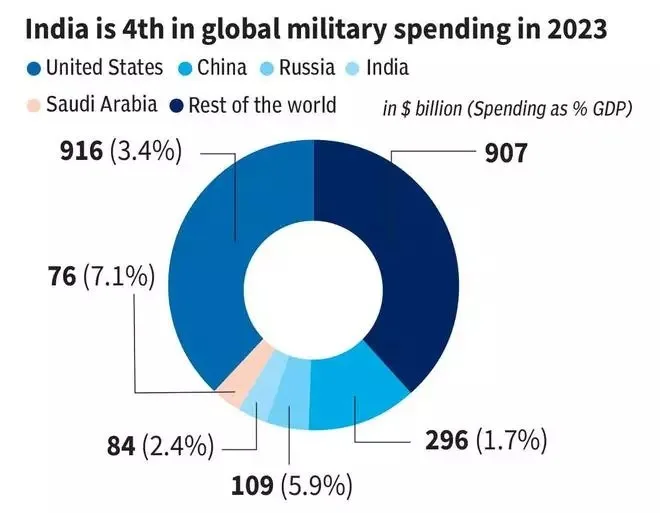Syllabus: GS3/ Defence
Context
- India’s defence sector is undergoing significant transformation, driven by modernization efforts, self-reliance initiatives, and strategic global partnerships. These developments aim to enhance military capabilities and position India as a major player in the global defence market.
India’s Defence Sector: Current Overview
Growth in Defence Production:
- Union Budget FY 2024-25: ₹6.22 lakh crore (approx. $75 billion) allocated to the Ministry of Defence.

- Indigenous Production: Achieved record growth in FY 2023-24 with ₹1,26,887 crore, a 16.7% increase from the previous year.
Growing Defence Exports:
- Defence exports rose 14 times between FY17 and FY24, reaching $2.6 billion.
- Future Targets: $5 billion by 2025 and $7 billion by FY30.
- Key markets: Southeast Asia, Africa, and the Middle East.

Budget Allocation:
- Capital outlay of ₹1.62 lakh crore in FY 2023-24 for indigenous procurement, reducing dependency on foreign suppliers.
Key Reforms in the Defence Sector
- Liberalized FDI Policy:
- FDI Limit: Increased to 74% (Automatic Route) and up to 100% (Government Route) for companies introducing modern technology.
- Domestic Procurement Prioritized:
- Initiatives like Make in India and Defence Acquisition Procedure (DAP) 2020 promote self-reliance.
- 2025 is declared as the ‘Year of Reforms’ for defence.
- Simplified Licensing:
- Extended validity periods for industrial licensing.
- iDEX Scheme:
- Encourages startups and MSMEs to participate in defence innovation.
- Indigenization Portal (SRIJAN):
- Facilitates collaboration between Indian industries and MSMEs for defence production.
- Defence Industrial Corridors:
- Established in Uttar Pradesh and Tamil Nadu to boost manufacturing.
- Private Sector Participation:
- Companies like Larsen & Toubro, Tata Advanced Systems, and Mahindra Defence Systems are strengthening the defence ecosystem.
Modernization of Armed Forces
- Army: Induction of Pinaka rocket launchers, Arjun Mark 1A tanks, and advanced rifles.
- Air Force: Adoption of Tejas LCA and procurement of Rafale jets.
- Development of the Advanced Medium Combat Aircraft (AMCA) for fifth-generation capabilities.
- Navy: Focus on indigenous platforms like INS Vikrant, INS Arighaat, and INS Tushil. Expansion under Project 75 and 75(I) for advanced submarines.
- Missile Systems: Development of BrahMos supersonic cruise missile and Akash SAM systems.
- Emerging Technologies: Integration of AI, cybersecurity, space-based assets, and quantum computing.
- DRDO’s focus is on unmanned systems, swarm drones, and hypersonic technology.
Opportunities in Defence Manufacturing
- Indigenization: 75% of the defence capital procurement budget in FY24 is allocated for indigenous sources.
- Modernization: Planned expenditure of $130 billion on fleet modernization in the next 5–7 years.
- Cost Savings: Lower manufacturing costs in India compared to Europe/North America.
- Strong Supply Chain: Over 350 major manufacturers and 10,000 MSMEs collaborate in the sector.
Key Challenges
- Dependence on State-Owned Enterprises:
- Public sector undertakings dominate defence production (~85% of output), limiting private sector efficiency.
- Indigenous Technology Development:
- Projects like the Kaveri engine highlight challenges in achieving advanced military technology.
- Slow Modernization:
- Delays in technological upgrades and procurement processes.
- Export Controls:
- Geopolitical complexities, such as Indian ammunition in unintended conflict zones (e.g., Ukraine), require careful navigation.
- Strategic Balancing:
- Partnerships with the USA, France, and Russia must be balanced with maintaining strategic autonomy.
- Bureaucratic Hurdles:
- Persistent delays in approvals and lack of inter-agency coordination.
Future Vision
- Global Ambitions:
- Establishing the Bharatiya Antariksh Station (BAS) by 2035 and achieving an Indian Crewed Lunar Landing by 2040.
- Advanced Launch Vehicles:
- Development of next-generation systems for the future battlefield.
- Enhanced Manufacturing:
- Expanding capabilities of industrial corridors and private sector participation.
Conclusion
- India’s defence sector is on a transformative path, marked by its pursuit of self-reliance, modernization, and global collaboration. While challenges such as technological hurdles and bureaucratic inefficiencies persist, India’s trajectory towards becoming a global defence manufacturing hub is clear. Continued reforms, enhanced private sector involvement, and strategic partnerships will strengthen India’s national security and solidify its role in the global defence landscape.
| Daily Mains Practice Question [Q] Evaluate how India’s defence sector is shaping up in the context of recent policy changes, modernization efforts, and strategic partnerships. What are the key challenges and opportunities facing the sector, and how can they be addressed to enhance India’s national security and defence capabilities? |
Previous article
China’s Expansionist Strategy: Implications and Countermeasures
Next article
Recasting Insolvency Resolution